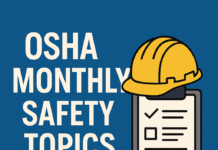
OSHA Safety Procedures: Ensuring Workplace Safety and Compliance
In the fast-paced world of business, ensuring the safety of employees is a top priority. One key aspect of achieving this is by adhering to OSHA safety procedures. Let’s delve into the world of OSHA and explore the essential guidelines that contribute to creating a secure work environment.
I. Introduction
A. Definition of OSHA Safety Procedures
Occupational Safety and Health Administration (OSHA) safety procedures are a set of regulations designed to ensure the safety and health of workers in various industries. These guidelines are in place to prevent workplace accidents and illnesses, fostering a secure working environment.
B. Importance of OSHA Compliance
Compliance with OSHA regulations is not just a legal requirement; it’s a commitment to prioritizing the well-being of employees. Businesses that adhere to OSHA standards not only avoid penalties but also create a culture of safety and responsibility.
II. OSHA Standards
A. Overview of OSHA Standards
OSHA sets the bar high when it comes to workplace safety. The standards encompass a wide range of industries, outlining specific measures to be taken to protect employees.
B. Common Safety Regulations
1. Personal Protective Equipment (PPE)
One cornerstone of OSHA regulations is the use of PPE. This includes equipment like helmets, gloves, and safety glasses, essential for safeguarding workers from potential hazards.
2. Hazard Communication
Effective communication about workplace hazards is crucial. OSHA mandates clear communication of potential dangers, ensuring that employees are aware and can take necessary precautions.
3. Emergency Action Plans
Preparation for emergencies is a key OSHA requirement. Businesses must have comprehensive plans in place, outlining procedures for evacuation, first aid, and other emergency responses.
III. Implementing OSHA Procedures
A. Creating a Safe Workplace
Ensuring a safe workplace starts with the physical environment. Employers must eliminate hazards and maintain a clean and organized workspace.
B. Training Employees on OSHA Regulations
Education is the first line of defense against accidents. OSHA mandates that employees receive proper training on safety protocols, including the use of equipment and emergency procedures.
C. Regular Safety Inspections
Routine inspections are crucial to identifying and rectifying potential hazards. OSHA compliance involves regular self-audits and inspections to maintain a safe working environment.
The Occupational Safety and Health Administration (OSHA) in the United States establishes safety procedures to ensure the well-being of workers. Here are some general OSHA safety procedures that employers and employees should follow:- Hazard Communication:
- Employers must communicate information about hazardous chemicals to employees through labels, safety data sheets (SDS), and training programs.
- Personal Protective Equipment (PPE):
- Employers should provide and ensure the use of appropriate PPE, such as gloves, goggles, helmets, or respirators, depending on the nature of the work.
- Machine Guarding:
- Machines and equipment must have proper guards to protect workers from moving parts, sharp edges, and other potential hazards.
- Fall Protection:
- Workers exposed to fall hazards should be provided with fall protection equipment, such as guardrails, safety nets, or personal fall arrest systems.
- Electrical Safety:
- Follow proper procedures for working with electricity, including lockout/tagout procedures, to prevent electrical shocks and other hazards.
- Fire Safety:
- Employers should have fire prevention plans, conduct regular fire drills, and provide appropriate firefighting equipment.
- Emergency Evacuation:
- Establish evacuation procedures and ensure that all employees are familiar with escape routes and assembly points in case of emergencies.
- Respiratory Protection:
- If employees are exposed to airborne contaminants, employers should provide respiratory protection and ensure proper fit and usage.
- Noise Control:
- Implement measures to control and reduce noise levels in the workplace to prevent hearing damage.
- Confined Space Entry:
- Develop and implement procedures for safe entry into confined spaces, including proper training and monitoring.
- Ladder Safety:
- Use ladders safely, following OSHA guidelines, and provide training on proper ladder usage to prevent falls.
- Material Handling:
- Train employees in safe lifting techniques, use proper equipment for material handling, and establish ergonomic work practices.
- Chemical Handling and Storage:
- Follow OSHA guidelines for the safe handling, storage, and disposal of chemicals to prevent exposure and accidents.
- Recordkeeping:
- Maintain accurate records of workplace injuries, illnesses, and safety training programs as required by OSHA regulations.
- Regular Inspections:
- Conduct regular inspections of the workplace to identify and address potential hazards promptly.
These are general guidelines, and specific industries may have additional OSHA regulations and requirements. Employers and employees should stay informed about OSHA standards and work together to create a safe and healthy work environment.IV. Benefits of OSHA Compliance
A. Reduced Workplace Accidents
Businesses that strictly adhere to OSHA procedures witness a significant decrease in workplace accidents. This not only protects employees but also minimizes downtime and associated costs.
B. Improved Employee Morale and Productivity
A safe workplace fosters a positive work culture. When employees feel secure, their morale improves, leading to increased productivity and overall job satisfaction.
V. Challenges in OSHA Compliance
A. Keeping Up with Changing Regulations
OSHA regulations are dynamic and subject to change. Staying informed about updates is a challenge businesses must overcome to maintain compliance.
B. Overcoming Resistance to Change
Implementing new safety procedures can face resistance from employees accustomed to existing practices. Overcoming this resistance requires effective communication and education.
VI. Case Studies
A. Successful Implementation of OSHA Procedures
Highlighting businesses that have successfully implemented OSHA procedures can serve as inspiration for others. Case studies provide real-world examples of the positive impact of compliance.
B. Consequences of Non-Compliance
Examining the consequences of failing to comply with OSHA regulations is a stark reminder of the importance of prioritizing safety. Penalties, legal issues, and reputational damage are potential outcomes.
VII. OSHA Resources
A. Online Resources and Tools
OSHA provides a wealth of online resources and tools to assist businesses in understanding and implementing safety procedures. These resources range from informative guides to interactive training modules.
B. OSHA Consultation Services
For personalized assistance, businesses can turn to OSHA consultation services. These services offer expert guidance on compliance, tailored to the specific needs of the organization.
VIII. Industry-Specific Guidelines
A. Tailoring OSHA Procedures to Different Industries
Recognizing that each industry has its unique challenges, OSHA allows for tailoring safety procedures to specific sectors. Understanding and implementing industry-specific guidelines are crucial for comprehensive safety.
B. Examples of Industry-Specific Safety Measures
Exploring specific safety measures within industries, such as construction, healthcare, or manufacturing, provides a deeper understanding of how OSHA guidelines are adapted for different work environments.
IX. Future Trends in OSHA Safety
A. Technological Advancements
As technology continues to evolve, so do safety measures. Embracing technological advancements enhances workplace safety, and businesses should stay abreast of these developments.
B. Emerging Safety Concerns
Identifying and addressing emerging safety concerns ensures that businesses are proactive in their approach to employee well-being. OSHA compliance evolves to meet new challenges in the modern workplace.
X. Conclusion
A. Recap of the Importance of OSHA Safety Procedures
In conclusion, prioritizing OSHA safety procedures is not just about meeting regulatory requirements; it’s about valuing the lives and well-being of employees. By following these guidelines, businesses create a foundation for success built on a culture of safety and responsibility.
B. Encouragement for Businesses to Prioritize Compliance
The journey toward OSHA compliance may pose challenges, but the benefits far outweigh the efforts. Businesses are encouraged to view safety as an investment, fostering a work environment where employees thrive, and the organization prospers.
OSHA Safety Officer Certification
OSHA Safety Manager Requirements
FAQs
- Why is OSHA compliance important for businesses? OSHA compliance is crucial for ensuring the safety and well-being of employees, reducing workplace accidents, and avoiding legal penalties.
- How often should businesses conduct safety inspections? Regular safety inspections should be conducted as part of an ongoing process, with frequency determined by the nature of the workplace and potential hazards.
- Can OSHA regulations be tailored to specific industries? Yes, OSHA allows for the customization of safety procedures to suit the unique challenges of different industries.
- What are the consequences of non-compliance with OSHA regulations? Consequences may include legal penalties, fines, reputational damage, and an increased risk of workplace accidents.
- Where can businesses find OSHA resources for compliance assistance? OSHA provides a range of online resources and consultation services to assist businesses in understanding and implementing safety procedures.

























In this module I have learnt consequence may legal penalties, fines and reputational damage and an increase risk of workplace accidents
Regular safety inspection should be considered as part of an ongoing process
Facing of challenges in different industries
Excellent job